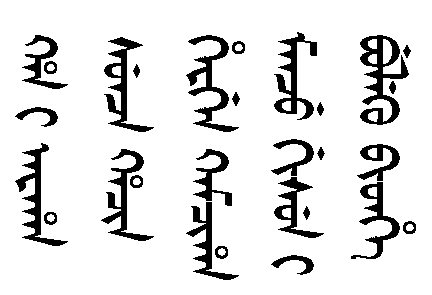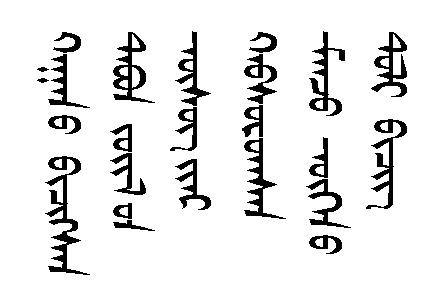Next
Previous
Contents
The Pentaglot is perhaps the most famous of all dictionaries which
were compiled under the Qing in the 17th and 18th centuries. Its
lemmata are recorded in five languages: Manju, Tibetan, Mongolian,
Uighur and Chinese; its full title in all languages reads as:
- Manju
-

han-i araha sunja hacin hergen kamciha
manju gisun-i buleku bithe
- Tibetan
-

rgyal pos mdzad pa'i skad lnga shan sbyar
gyi manydzu'i skad gsal ba'i me long .
- Mongol
-

xaGan-u bicigsän tabun züil-ün üsüg-iyär
xabsuruGsan manzu ügän-ü toli bicig
- Uighur
-

han-ning pütügän bäsh qysmi qoshqan
hät mancu söz ning ayri majin häti
- Chinese
-

Yuzhi Wu Ti Qing Wen Jian
Based on
earlier lexicographical work (most of these are Manju-Chinese
dictionaries), the Pentaglot differs from most of the Manju dictionaries
by the number of languages (it has five, hence the name; the
above-mentioned Manju, Tibetan, Mongolian, Uighur and Chinese),
the notational systems (Tibetan is accompanied by a transliteration
and a transcription in Manju, Uighur is accompanied by a transliteration
in Manju whereas Mongolian appears without Manju transliteration as seen
in early Manju and Mongolian dictionaries) and the arrangement of entries
which is strictly semasiological (classified by meanings). Including several
appendices, the Pentaglot has a total of 18671 entries, but no index. Words
in any given language can be looked up only by browsing its huge table
of contents which runs all five languages in parallel. In contrast to
classified dictionaries called jian in Chinese, dictionaries arranged by
alphabetical order are frequently called hui in Chinese.
Manuscripts (there does not seem to be an official printed edition of
the 18th century) survived in the Imperial Palace in Beijing and Manchuria.
The Imperial Palace Pentaglot was reproduced photomechanically in three
volumes in Beijing in 1957 with a total of 4973 corpus pages each featuring
usually four entries. Besides the corpus it has a useful annex stating in
tabular form the history of the Pentaglot. Differences between the manuscripts
exist as can be seen from the Japanese romanized edition (see below).
Occasionally there are technical mistakes to be found like repeated Mongolian
items where the keyword has changed, and omissions of single Chinese
characters (most probably by negligence of the copyist). Also, the Mongolian
orthography of dotted consonants (like G) is not stable; sometimes
Gurban looks like xurban (just one frequently mentioned
example), and suffices appear frequently in a colloquial form:
-bar becomes -var and is attached to the stem of the word.
The Beijing 1957 edition of the Pentaglot was reprinted in 1997/1998 and
was (at least during 1998) available at the Nationalities' Publishing
House (Minzu Chubanshe) bookshop in Beijing. The 1957 edition can be
found at most major Central Asian and Sinological libraries (at least the
author saw it in all the ones which he visited so far). Its Chinese name
(by which it is usually referred to) reads:
[Yuzhi] Wu Ti Qing Wen Jian
A mirror (jian) of Manju (Qing wen) in five incarnations
(wu ti) where jian stands for dictionaries arranged by meaning.
Sometimes the prefix [Yuzhi made by Imperial {order}] is carried,
sometimes not; the book itself remains the same.
In 1966/67 a group of Japanese scientists (Tamura Jitsuzou,
Imanishi Shunjuu and Satou Hisashi) compiled a translation
of and an index to the Wu Ti Qing Wen Jian (Gotai Shinbun Kan
Yakkai, Institute for Inland Asian Studies, Faculty of Letters,
Kyouto University) but
despite its volume the books has its shortcomings. Mongolian is transcribed
according to vaguely applied Manju readings which makes it difficult
enough to read, let alone retransliterate the Mongolian entries. Also, the
oddities in the Mongolian orthography are not carefully reflected in the
transcription.
In 1956, a Mengwen Fenlei Cidian (Classified Mongolian Dictionary)
was produced by the Nationalities Press (Minzu Chubanshe) which was
then given a second edition in 1978 (mongGol udx=a-yin züil
xubiyaGsan toli bicig). With no word the preface mentions that this
is the Mongolian-Chinese subset of the Pentaglot! The preface just
says things like ``is a piece of national culture heritage, useful for
translating and researching Mongolian...''.
This title does not show the original pagination and uses simplified
characters throughout the Chinese glosses; also the sometimes awkward
orthography of Mongolian entries is flattened to a modern standard
orthography which forces the reader to use the original edition if she
is interested in orthographic issues. Anyway, this edition is useful
to the extent that one does not have to carry the three huge volumes of
the 1957 issue when on travel.
In 1990, Qinghai Minzu Chubanshe issued a Chinese-Tibetan extract of
the Pentaglot, Yuzhi Wu Ti Qingwen Jian - Han-Zang Wenjian Zhuanji.
It shows similar limitations: the entries are arranged in Chinese-Tibetan
order rather than the original Tibetan-Chinese, the pagination is not
documented (which makes things a bit complicated because entries belonging
into the original annex were relocated into the main text), the
Chinese equivalents are presented in simplified characters, etc.
Portions of the Pentaglot were described and reviewed earlier by Haenisch
(Die Abteilung ``Jagd'' im fünfsprachigen Wörterspiegel,
Asia Major X (1934), p. 59-93), K. Himly (Die Abteilung der Spiele im
Grossen Wörterspiegel, T'oung Pao V (1894), VII (1896), VIII (1897),
IX (1898), X (1899)) e.a. but these portions usually cover only single sections
(mong. züil, chin. lei, tib. skor) of the original text.
The author does not know whether there are any editions of the Manju or Uighur
subsets of the Pentaglot.
Next
Previous
Contents




